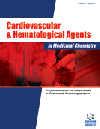- Home
- A-Z Publications
- Cardiovascular & Hematological Agents in Medicinal Chemistry (Formerly Current Medicinal Chemistry - Cardiovascular & Hematological Agents)
- Previous Issues
- Volume 5, Issue 4, 2007
Cardiovascular & Hematological Agents in Medicinal Chemistry (Formerly Current Medicinal Chemistry - Cardiovascular & Hematological Agents) - Volume 5, Issue 4, 2007
Volume 5, Issue 4, 2007
-
-
Inhibition of Renin-Angiotensin System and Advanced Glycation End Products Formation: A Promising Therapeutic Approach Targeting on Cardiovascular Diseases
More LessAuthors: A. Geronikaki, A. Gavalas, V. Dislian and G. GiannoglouCardiovascular disease remains the leading cause of death worldwide. The renin-angiotensin-aldosterone system (RAAS) plays a key role in the regulation of blood pressure, through the actions of angiotensin (Ang) II. Excessive RAAS activity may lead to hypertension and associated target organ damage. Indeed, RAAS blockade with angiotensin converting enzyme inhibitors (ACEIs) and/or angiotensin receptor AT (1) blocker Read More
-
-
-
The Role of Endothelial Progenitor Cells and Statins in Endothelial Function: A Review
More LessEndothelial dysfunction, a well recognized marker of cardiovascular risk, is an early event in artheriosclerosis process. Diabetes mellitus, hypertension and dyslipidemia, known risk factors for coronary disease have been associated with endothelial dysfunction, which improves after the control of these factors. Statins have additional benefits on endothelial function not related to decreasing cholesterol levels, known a Read More
-
-
-
Pharmacological Activity of Cardiovascular Agents from Herbal Medicine
More LessAuthors: John W. Ho and Meng JieSome of the active phytochemicals in herbal medicine are finding therapeutic use. For example, patients with heart disease are reported to benefit from treatment with herbal medicine with fewer side effects. Previous studies showed the inhibitory effects of tetramethylpyrazine, an active component of medicinal herb, on phosphodiesterase that is associated with heart disease and the cardio-protective effects of other her Read More
-
-
-
Porphyrin-Photosensitized Processes: Their Applications in the Prevention of Arterial Restenosis
More LessAuthors: M. Magaraggia, L. Marigo, A. Pagnan, G. Jori and A. VisonaPhotodynamic therapy (PDT) is based on the use of a photozensitising compound which is accumulated by rapidly proliferating cells. Subsequent irradiation with light wavelengths specifically absorbed by the photosensitiser promotes the generation of reactive short-lived oxygen species which cause an irreversible and selective damage. Endovascular interventions to correct obstructive arterial disease have been developed wor Read More
-
-
-
Preclinical Testing of Drug-Induced Proarrhythmia: Value of Transgenic Models
More LessAuthors: L. Fabritz, G. Breithardt and P. KirchhofDrug-induced proarrhythmia is a serious medical problem that causes relevant morbidity and mortality. It is also a relevant problem for the development of novel pharmacological compounds. Therefore, there is a need for sensitive, specific and high-throughput preclinical tests to detect a risk for drug-induced proarrhythmia early in the development of new drugs. The review focuses on the potential role of transgenic mo Read More
-
-
-
The Importance of Lost Minerals in Heart Failure
More LessThe clinical syndrome congestive heart failure (CHF) has its origins rooted in a salt-avid state mediated largely by effector hormones of the renin-angiotensin-aldosterone system (RAAS). In addition, a systemic illness accompanies chronic RAAS activation. Its features include: the presence of oxidative stress in diverse tissues coupled with a reduction in activity of endogenous oxidoreductases, such as Cu/Zn-superoxide dismuta Read More
-
-
-
Targeting the Sarcolemmal Calcium Pump: A Potential Novel Strategy for the Treatment of Cardiovascular Disease
More LessAuthors: Delvac Oceandy, Mamas A. Mamas and Ludwig NeysesIntracellular calcium dynamics play a very important role in mediating contraction and signalling in cardiomyocytes and vascular smooth muscle cells. A number of calcium transporters have been identified that orchestrate a complex process of excitation-contraction coupling and molecular signalling. Despite the variability of the calcium transporters expressed in cardiomyocytes, most calcium channel blockers used therape Read More
-
-
-
von Willebrand Factor, von Willebrand Factor-Cleaving Protease, and Shear Stress
More LessAuthors: P. Perutelli and A. C. Molinarivon Willebrand factor (VWF) is a multimeric plasma glycoprotein (GP) involved in platelet adhesion at the site of vascular damage, which acts as a bridge between the injured subendothelium and the platelet receptors. The multimeric structure of VWF allows it to support multiple interactions with platelets and endothelial components under high shear stress. Rapid flow conditions induce a conformational transition of the VWF Read More
-
-
-
Endocannabinoid Regulation of Matrix Metalloproteinases: Implications in Ischemic Stroke
More LessAuthors: Somnath Mukhopadhyay and David A. TulisStroke is a major cause of morbidity and mortality and follows heart disease and cancer as the third leading cause of death in Western societies [1]. Despite many advances in stroke research and pharmacotherapy, clinical treatment of this debilitating disorder is still inadequate. Recent findings from several laboratories have identified the endocannabinoid signaling pathway, comprised of the endocannabinoid agonist anandamid Read More
-
-
-
Developing Specific Therapeutic Strategies for Transfusion-Related Acute Lung Injury. An Overview of Potentially Useful Animal Models
More LessTransfusion-related (TR)- acute lung injury (ALI) is the leading cause of transfusion-related morbidity and mortality. The pathogenesis of TRALI is thought to be a “two hit”-entity: the “first hit” is (any) proinflammatory pulmonary condition (e.g., pneumonia, sepsis or lung contusion) resulting in activation of lung endothelium with sequestration of polymorphonuclear neutrophils - the “second hit” is provided by transfusion of a blo Read More
-
Volumes & issues
-
Volume 23 (2025)
-
Volume 22 (2024)
-
Volume 21 (2023)
-
Volume 20 (2022)
-
Volume 19 (2021)
-
Volume 18 (2020)
-
Volume 2 (2020)
-
Volume 17 (2019)
-
Volume 16 (2018)
-
Volume 15 (2017)
-
Volume 14 (2016)
-
Volume 13 (2015)
-
Volume 12 (2014)
-
Volume 11 (2013)
-
Volume 10 (2012)
-
Volume 9 (2011)
-
Volume 8 (2010)
-
Volume 7 (2009)
-
Volume 6 (2008)
-
Volume 5 (2007)
-
Volume 4 (2006)
Most Read This Month
Article
content/journals/chamc
Journal
10
5
false
en


